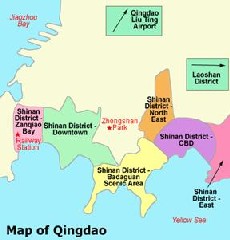Qingdao City Facts & District
Qingdao is a city steeped in China's 20th century history. An
ancient city, Qingdao was taken as a German colony in 1897. During
their 17 year colonial period, the Germans left a distinct mark
on Qingdao's architecture that can still be seen today in its
historic center and train station. It is a kind of "Bavaria-on-the-East-China-Sea",
where locals still sell Bratwurst on the street. And in no other
place in China do people drink as much beer as in Qingdao. In
1903, the world-famous Tsingtao brewery was established by homesick
Germans. And every August Qingdao holds a Beerfest to celebrate
its favorite libation. During World War I, the Japanese took
over the city; they were ousted during the 1918 May 4th Movement
but retook the city in 1938.
Since the 1984 inauguration of China's open-door policy to foreign
trade and investment, Qingdao has developed quickly as a modern
port city. Aside from being the headquarters of the Chinese navy's
northern fleet, Qingdao is now a manufacturing center, and home
to Haier Corporation a major electronics firm. The city has recently
experienced a rapid growing period, with a new central business
district created to the east of the older business district.
Outside of the center of the city there is a large industrial
zone, which includes chemical processing, rubber and heavy manufacturing,
in addition to a growing high tech area.
Qingdao City Facts
Qingdao District Guides
Population |
7 million |
Land Area |
10, 654 square kilometers (4114
square miles) |
Administration Type |
Sub-Provincial City |
County Level Divisions |
12 |
Coastline |
862.64 km (including offshore
islands) |
Zip Code |
266000 |
Area Code |
532 |
Major Nationality |
95.48% Han |
City Flower |
China Rose |
Major Industries |
Farming, Chemical Production,
Rubber, Textile, Tourism |
Electricity |
220 volts, 50 Hz; standard
two-pin plug |
Time Zone |
GMT +8 hours |
Mining Resources |
Graphite and including ornamental
granite, decorative marble, mineral water, diopside, gold,
talk and zeolite. There are also deposits of heavy
crystal stones, dolomite, dilative soil, potash feldspar,
quartzite, pearlite, and flourspar. |
The sub-provincial city of Qingdao administers 12 county-level
divisions, including 7 districts and 5 county level cities (Jimo
City, Jiaozhou City, Jiaonan City, Pingdu City, Laixi City).
Please read below for more information regarding Qingdao's various
districts.
Shinan District
Better known as downtown, this district sparkles as Qingdao's
glamour center. The Zhanqiao Pier, Little Qingdao Isle, and
the famous Badaguan Scenic Area are just a few of its tourist
magnets. All of Qingdao's major beaches, including Beach Number
One, can be found here as well. This is the district you need
to know if arriving as a tourist.
Shibei District
Directly north of downtown along Jiaozhou Bay, this district
is better known for industry. It contains most of Qingdao's major
shipping piers.
Sifang District
Sifang District is located north of Shibei. Since it packed with
the city's industry, it too is low on tourist options.
Licang District
Located farther up the peninsula, north of Sifang, Licang District
is home to the area's Peach Blossom Tourism Spot. It caters to
huge crowds during the spring blossom season. The Zhengzhuang
Industrial Park can also be found here.
Laoshan District
Situated to the southeast of downtown Laoshan District harbors
the magical Laoshan Mountains. Hiking trails are many, leading
to the world famous Mount Taishan and towering Jufeng Peak. Many
lodging can be found along the coastal shores, including the
Golden Beach Hotel.
Hengyang District
Chengyang District is Qingdao's most northern district and is best known for
being central area for Qingdao's electronic, machinery, and chemical engineering
industries.
Huangdao District
Huangdao District is an island located to the southwest of Qingdao.
It is also known for its industrial headquarters. The Huangdao
Wharf, one of the area's largest, is industrially legendary for
accommodating 200,000 ton oil tankers.
|




